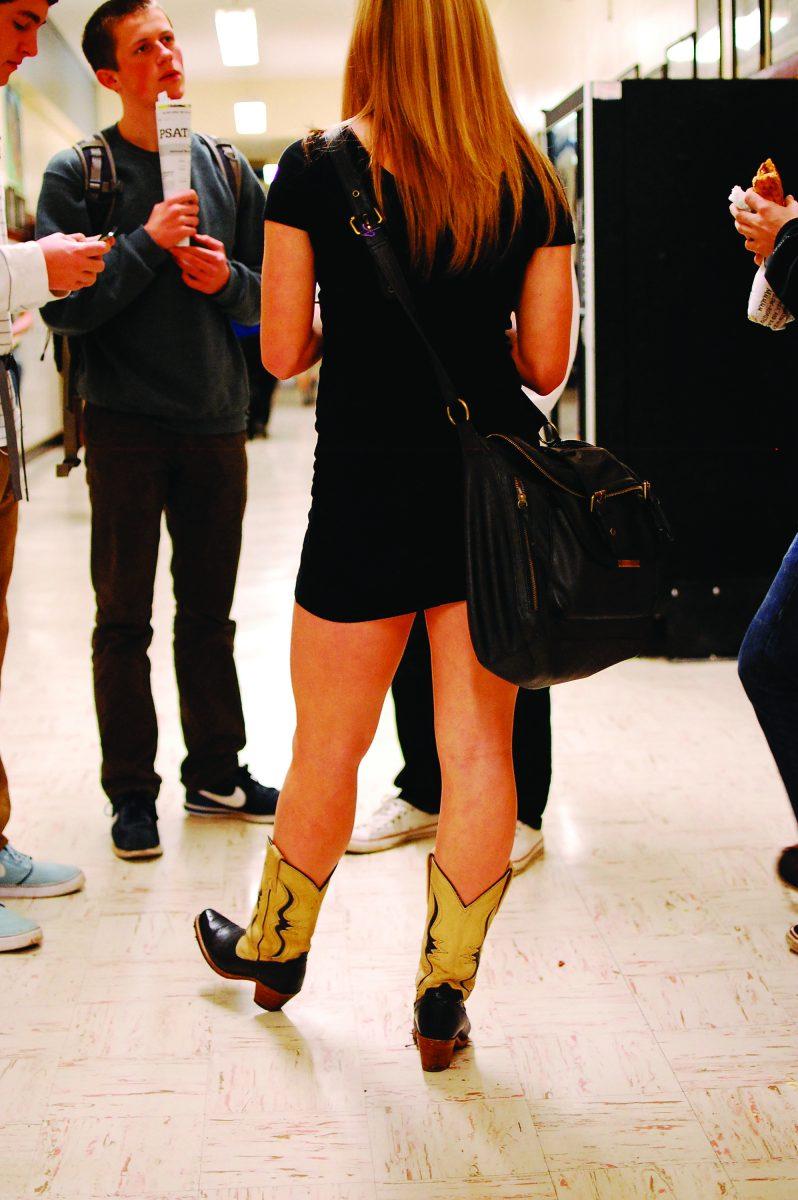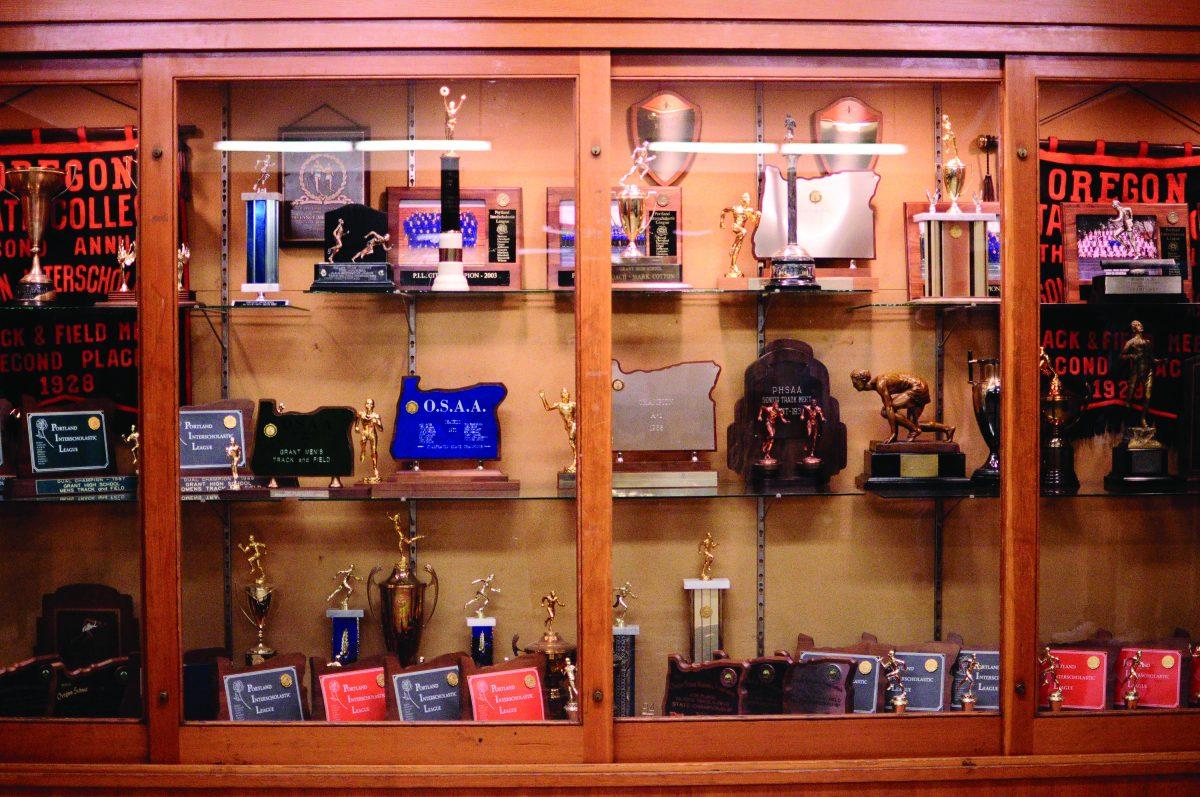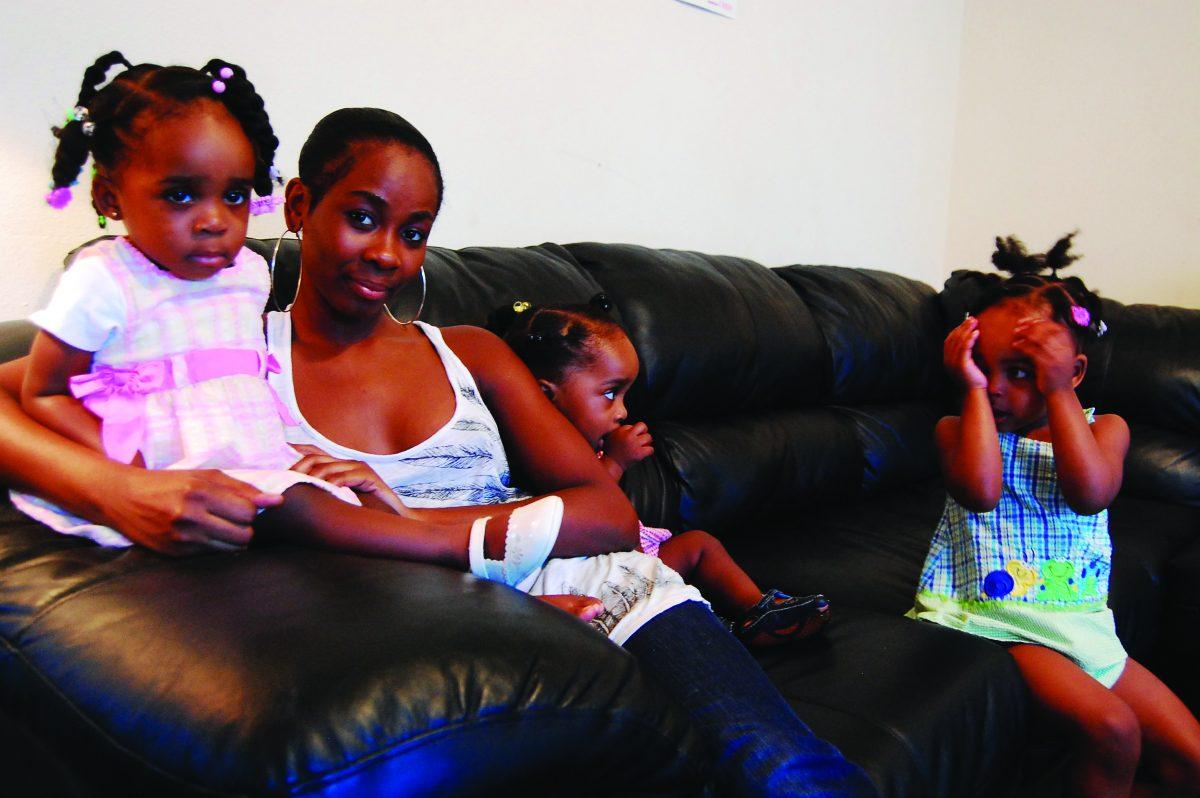It’s 39 degrees on a recent winter morning. The bell is about to ring to signal the start of school at Grant. A girl walks through the doors wearing a tight black dress that stops a quarter of the way down her thigh and scoops down low in the front, revealing her cleavage.
Hindered by her high heels, she prances past a group of boys whose pants are sagging close to their knees with their baseball caps propped sideways on their heads. They slow down to check her out before a security guard motions them to head to class and the boys shuffle away.
Later in another classroom, the underwear of girls sitting in their short tight skirts is clearly visible to students sitting across from them.
While Grant has an official dress code, it’s clear that student fashion in recent years has pushed the limit at the school and beyond. Some adults connected to Grant say they worry about how kids look and that taking your appearance seriously is important. “A lot of students dress like they’re going to the club on a Tuesday morning,” says Curtis Wilson, the Grant vice principal in charge of discipline.
Students say that showing a little skin isn’t a bad thing. And sagging pants? “We sag a little. So what?” some boys say. After all, boys and girls trying to impress each other is a part of what high school is all about. And some students are openly defiant about how they dress.
“My parents don’t care what I wear or how I dress, but teachers sometimes judge and get all weird,” says sophomore Grace Higgins. “I don’t care because it’s my thing. I have been told to stop the crop top by teachers, but I’m going to keep it because it’s how I am and it’s always been my style.”
Regardless of the views, one thing is certain: The way teens dress has everyone from students, teachers, parents and others in the Grant community talking. Is the dress code being enforced? Depends on who you ask.
It “isn’t a top priority,” Wilson says, citing a lack of staffing. If administrators made cracking down on dress a top priority, more important issues would go unaddressed. Mostly, discretion about what clothes are appropriate in school is left up to teachers and other staff who can send kids to the office if necessary.
clothes are appropriate in school is left up to teachers and other staff who can send kids to the office if necessary.
Math teacher Pat Herrington recalls seeing kids who “can’t even focus because somebody next to them is dressed inappropriately.” Herrington admits the policy is hard to enforce.
“Ninety percent of the time, they just continue to do whatever they’re going to do and make a big joke about it,” she says.
Students differ on what’s OK and what’s not.
Bra straps and underwear showing are other frequent occurrences in the Grant halls. Freshman Claire Lupfer doesn’t like what she sees.
“If you’re intentionally trying to show your bra, I feel like that’s going a little past the line,” she says.
Junior Max Glicker says: “Bra straps themselves are not sexy. It’s what they represent.” But he concedes that sometimes they can be “a little bit trashy.”
In the end, sophomore Madi Moskowitz points to what most students recognize makes dress a hot topic: “At school, I feel like I can wear whatever I want.”
According to the Portland Public Schools code of conduct, the point of the dress code is to assure a healthy learning environment free of indecency. But the code appears vague in some areas, banning only “dressing or grooming in a manner that disrupts the educational process or climate” and is “a threat to the learning opportunity.”
So schools are left to develop their own guidelines. At Grant, students are permitted to wear everything except dress that “shows an amount of flesh that shouldn’t be shown,” specifically “navels showing, strapless tops and skirts where you can see someone’s bottom,” says Wilson, adding that hats and sagging are also off-limits.
The specifics of the code target students of both genders, but some feel the code is enforced in a way that targets girls. “Nobody ever tells a guy to wear modest clothing,” junior Morgan Grover says.
 Standards of appropriate attire clearly are different for girls and boys. Boys wear hats and sag, undoubted code violations. But it’s also easy for boys to pull up their pants – in most cases temporarily – and to remove their caps. When a female student shows skin, a few words don’t always fix the problem.
Standards of appropriate attire clearly are different for girls and boys. Boys wear hats and sag, undoubted code violations. But it’s also easy for boys to pull up their pants – in most cases temporarily – and to remove their caps. When a female student shows skin, a few words don’t always fix the problem.
When Principal Vivian Orlen started her job last year, she made a point of having extra T-shirts and sweatshirts handy to get some girls to cover up. The office supply quickly ran out.
Other Grant staff members shy away from the issue.
“I don’t hesitate to tell the boys to pull up their pants, but I won’t tell a girl that she’s baring too much cleavage,” admits library assistant Marni Fuller. “It’s more uncomfortable for me.”
Herrington stored extra shirts in her room to lend to girls, but stopped when she wasn’t getting them back. To become “school appropriate,” some girls must completely change their outfits. Sometimes that warrants a trip home.
Dress is one of the most important aspects of teen culture. Walk into any trendy store and the first thing you see are tiny skirts and revealing shirts. Jeans and khakis on display largely are oversized – the more room to sag, the better the swag. Magazines and TV shows regularly hype up the latest look. And the clothes worn by pop and hip hop stars continually help push the envelope.
Connie Hines says the oversexualization of teens in the media contributes to a culture of indecency. She says that as students mature, they want to impress their peers. But dressing scantily may attract the wrong kind of attention.
Hines says students are “growing up and starting to be young adults, and they want to impress the young population that’s here.” Specifically the opposite sex.
Lee D. Baker, the dean of academic affairs at Duke University, has published work about teen popular culture. In an e-mail interview, Baker said what’s happening at Grant plays out across the country every day. And it’s not likely to stop anytime soon.
“Popular culture has always pushed the limits of sexuality, what is sexy and how much skin to show,” Baker said in the interview. “Schools are about learning, but they also are arenas where people perform their identity and form relationships. Fashion and performing one’s identity have always been an integral part of high school.”
Baker looks in depth into why young people sag in his essay, “Saggin’ and Braggin’,” which was published in Anthropology off the Shelf: Anthropologists on Writing. He calls sagging “a style that has been putatively associated with gang violence, disrespect of authority, and a general sense that it is possible but not probable to make it in America.”
But sagging at Grant covers a far wider range of students than just this demographic. Sequoya de Nevers, a senior says he sags because he has “some really cool boxers on and wants everyone to see them.” He hasn’t been deterred, even after receiving a referral. His mother disagrees.
“It’s unattractive to have your butt and underwear hanging out of your pants,” says Susan Charnley. “I can’t imagine it’s comfortable to walk along with the crotch of your pants halfway down your butt.”
Greg de Nevers brushes off his son’s choice of dress as a generational difference. “It’s just like when high schoolers in my generation wore holes in their blue jeans and braids halfway down their backs,” Greg de Nevers says. “Every generation has its way of distancing itself from parents and authority.”
And distancing we are. Madeline Kokes, who runs the Grant College and Career Center, describes herself as a lover of “creative self-expression.” But she admits being caught off guard by what students wear these days.
“If it’s a festive occasion, you can show a little skin,” says the mother of two Grant students. “But not in the school. There are a million and one ways to express yourself through dress that don’t include dressing in such a suggestive manner.”
Kokes remembers taking students on a field trip, and being embarrassed by the sagging. “You’re preparing yourselves to go out into the real world,” she remembers telling the boys. “That is so unprofessional.”
The punishment for dress code violations at Grant varies depending on how frequently the individual errs on the side of inappropriate. Wilson acts accordingly: a level one violation—an isolated incident—merits a conference. Level two violations require a parent-teacher meeting. On level three, repeat offenders are subject to a referral, suspension, or even temporary expulsion.
 Wilson says he frequently has level one conferences, but has never handed out a level two or three punishment. Some school districts in Florida and Georgia, though, have gone on the offensive, fining students for sagging and other inappropriate dress.
Wilson says he frequently has level one conferences, but has never handed out a level two or three punishment. Some school districts in Florida and Georgia, though, have gone on the offensive, fining students for sagging and other inappropriate dress.
Setting standards can be a badge of honor or a curse, depending on who you ask. Sequoya de Nevers says the arbiters of what’s fashionable are “pop culture and the senior class.”
“It’s intimidating to be a freshman,” Junior Mickayla Korth says. “You’re at the bottom of the food chain and you want to fit in and impress the upperclassmen.”
Freshman Lily Gould agrees. “When one person wears one, everybody else wears one,” she says, referring to the tight tube skirts that are popular among girls.
Hines says she’d like to see Grant require students to wear a uniform. “Everybody would be the same,” she says. “Nobody would have to go around out-dressing each other.”
Kokes has two pieces of advice for Grant students who think their state of dress – or undress – doesn’t have an impact on their future.
“To the girls I would say: Do you want to be respected? Do you want to be seen as an object or do you want to be respected for your mind?” she asks. “To the boys: Have respect, cover up your private parts, engage your mind and get on with your business. You have to have standards for yourself. Nobody will take you seriously if you’re sagging or dressed in a suggestive manner.”


































